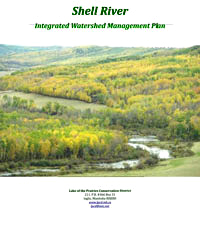Shell River Integrated Watershed Management Plan
|
The Shell River Integrated Watershed Management Plan encompasses the area of land which contributes water to the Shell River, including tributaries such as Lake of the Prairies, Shell River, and Boggy Creek. The Lake of the Prairies Conservation District is leading plan implementation in partnership with the Provincial government and a team of supporting agencies, interest groups and watershed residents. |

|
|
It takes approximately two years to develop an integrated watershed management plan. The timeline on the right illustrates plan development progress. Once a plan is implemented the water planning authority can publish reports which track progress on achieving planning goals. |

|
Once a plan is initiated in an area a memorandum of understanding is developed between the water planning authority and the Province of Manitoba. The planning team then lays out the terms of the plan, including the timeline, budget, and scope of work.
Public consultations are held to better understand the concerns and issues of the watershed. The planning team invites watershed residents through a variety of announcements. If public consultations have occurred, the results of the issues discussed at public consultations are summarized here.
The planning team asks technical experts and relevant stakeholder groups to provide information and issues about the watershed. A significant amount of valuable information is provided by:
Manitoba Environment and Climate Change
Many other government departments, agencies and stakeholder groups.
Through a series of meetings with representatives from the Conservation District, and a broad range of technical and stakeholder representatives, a draft management plan is developed. Once this plan is reviewed by the public, the water planning authority and the Minister of Environment and Climate Change, an approved plan is published and plan actions are implemented.



